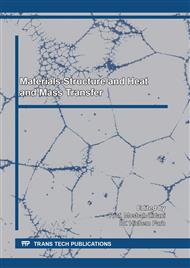[1]
Bachelor, G. K., Heat transfer by free convection across a closed cavity between vertical boundaries at different temperatures, J. Appl. Math., vol. 12, pp.209-233, (1954).
DOI: 10.1090/qam/64563
Google Scholar
[2]
Gill, A. E., The boundary layer regime for convection in a rectangular cavity, J. Fluid Mech., vol. 26, pp.515-536, (1966).
DOI: 10.1017/s0022112066001368
Google Scholar
[3]
Okuyama, K., Kousaka, Y., Yamamoto, S., &Hosokawa, T. , Particle loss of aerosols with particle diameters between 6 and 2000 nm in stirred tank, J. Colloids and Interface Science, vol. 110, p.214–223, (1986).
DOI: 10.1016/0021-9797(86)90370-x
Google Scholar
[4]
Chen, B.T. Yeh, H.C., Cheng Y.S., Evolution of an environmental reaction chamber, Aerosol Science and Technology, vol. 17, pp.9-24, (1992).
Google Scholar
[5]
Wahba, E.M., Steady flow simulations inside a driven cavity up to Reynolds number 35,000, Computers & Fluids, vol. 66, pp.85-97, (2012).
DOI: 10.1016/j.compfluid.2012.06.012
Google Scholar
[6]
Bhuiyana, A., Rezwanul, M.D., Harta, T., Rahmanc, M.M. and Jamal, N., Experimental and numerical investigation of coherent structure dynamics on mass transfer in a separated cavity flow, Experimental thermal and fluid science, vol. 76, pp.146-162, (2016).
DOI: 10.1016/j.expthermflusci.2016.07.019
Google Scholar
[7]
Oudina, F. M., Bessaïh, R., Numerical simulation of natural convection heat transfer of copper-water nanofluid in a vertical cylindrical annulus with heat sources, Thermophysics and Aeromechanics, vol. 26, p.325–334, (2019).
DOI: 10.1134/s0869864319030028
Google Scholar
[8]
Raza, J., Oudina, F. M., Mahanthesh, B., Magneto hydrodynamic flow of nano Williamson fluid generated by stretching plate with multiple slips, Mul. Mod. in Mat. and Str., (2019).
DOI: 10.1108/mmms-11-2018-0183
Google Scholar
[9]
Gourari, S., Mebarek-Oudina, F., Hussein, A. K., Kolsi, L., Hassen, W., Numerical study of natural convection between two coaxial inclined cylinders, Int. Inf. and Eng. Tech. Asso., pp.779-786, (2019).
DOI: 10.18280/ijht.370314
Google Scholar
[10]
Laouira, H., Oudina, F. M., Hussein, A. K., Kolsi, L., Merah, A., Younis, O., Heat transfer inside a horizontal channel with an open trapezoidal enclosure subjected to a heat source of different lengths, J. Heat Transfer-Asian Res, pp.1-18, (2020).
DOI: 10.1002/htj.21618
Google Scholar
[11]
Yilbas, B.S., Shuja, S.Z.and Budair, M.O., Jet impingement onto a conical cavity with elevated wall temperature, International Journal of Numerical Methods for Heat & Fluid Flow, vol. 14, no. 8, pp.101-1028, (2004).
DOI: 10.1108/09615530410557423
Google Scholar
[12]
Couton, D., Marchal, F., Doan-Kim, S., and Tanguy, C.H., Interaction of a cold wall jet with a natural convective flow in a confined opened cavity, the American society of mechanical engineers; 1, pp.783-91, (2004).
DOI: 10.1115/ht-fed2004-56677
Google Scholar
[13]
Wang, X., Naji, H., and Mezrhab, A., Computational heat transfer in enclosed environment with a v2-f model, Conference: 6th Int. Conference on Computational Heat and Mass Transfer, vol. 271, pp.171-175, (2009).
Google Scholar
[14]
Chen, H., Moshfegh, B., Cehlin, M., Numerical investigation of the flow behavior of an isothermal impinging jet in a room, J. Building and Environment, vol. 49, pp.154-166, (2012).
DOI: 10.1016/j.buildenv.2011.09.027
Google Scholar
[15]
Chen, H., Experimental and numerical investigations of a ventilation strategy impinging jet ventilation for an office environment,.
DOI: 10.3384/diss.diva-106483
Google Scholar
[16]
Halouane, Y., Mataoui, A., Iachachene, F., Turbulent jet impinging a cylindrical hot cavity, J. Heat and Mass Transfer, vol. 50, no. 8, pp.1155-1166, (2014).
DOI: 10.1007/s00231-014-1327-z
Google Scholar
[17]
Prabu, P.M., and Padmanaban, K.P., Laminar wall jet flow and heat transfer over a shallow cavity, J. Scientific World, (2015).
DOI: 10.1155/2015/926249
Google Scholar
[18]
Guana, T., Jing-zhou, Z., Yong, S. and Jin, H., Conjugate heat transfer on leading edge of a conical wall subjected to external cold flow and internal hot jet impingement from chevron nozzle – Part 1: Experimental analysis, Int. J. Heat and Mass Transfer, vol. 106, pp.329-338, (2016).
DOI: 10.1016/j.ijheatmasstransfer.2016.06.101
Google Scholar
[19]
Singh, T. P., Kumar. A., and Satapathy, A. K., Fluid flow analysis of a turbulent offset jet impinging on a wavy wall surface, J. Mechanical Engineering Science, pp.1-20, (2019).
DOI: 10.1177/0954406219880209
Google Scholar
[20]
Amitesh, K., Mean flow characteristics of a turbulent dual jet consisting of a plane wall jet and a parallel offset jet, J. Computers & Fluids, vol. 114, p.48–65, (2015).
DOI: 10.1016/j.compfluid.2015.02.017
Google Scholar
[21]
Ahlman, D., Brethouwer, G., and Johansson, A.V., Direct numerical simulation of a plane turbulent wall-jet including scalar mixing, J. Physics of Fluids, vol. 19, no. 6, pp.102-113, (2007).
DOI: 10.1063/1.2732460
Google Scholar
[22]
Iftekhar, Z., Tucker, G., and Yan, L., Large-eddy simulation of the interaction of wall jets with external stream, Int. J. Heat and Fluid Flow, vol. 50, pp.431-444, (2014).
DOI: 10.1016/j.ijheatfluidflow.2014.10.014
Google Scholar
[23]
Ayech, S.B.H., Habli, S., Saïd, N.M., Bournot, P., and Palec, G.L., A numerical study of a plane turbulent wall jet in a coflow stream, J. Hydro-environment Research, vol. 12, pp.16-30, (2016).
DOI: 10.1016/j.jher.2016.02.001
Google Scholar
[24]
Kuznik, F., Rusaouen, G., and Brau, J., Experimental study of turbulent structures in a non isothermal horizontal jet issuing from a round nozzle distanced from a wall, Int. J. Ventilation, vol. 10, no. 3, pp.277-290, (2011).
DOI: 10.1080/14733315.2011.11683955
Google Scholar
[25]
Menter, F.R., Two-equation eddy-viscosity turbulence models for engineering applications, AIAA J , vol. 32, (1994).
DOI: 10.2514/3.12149
Google Scholar


